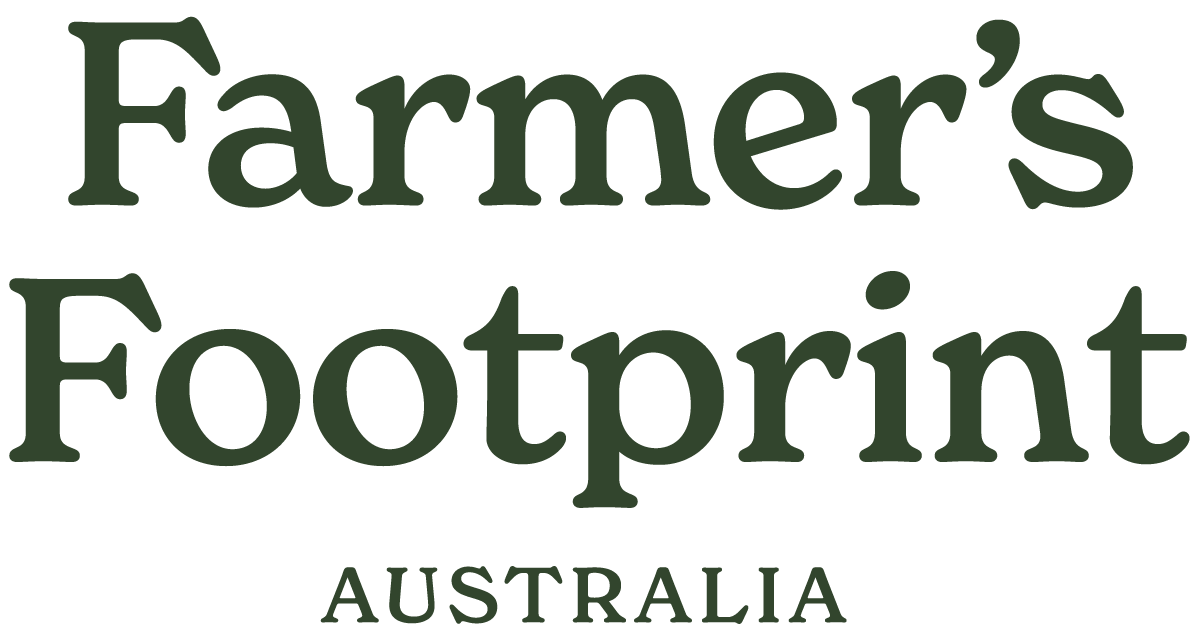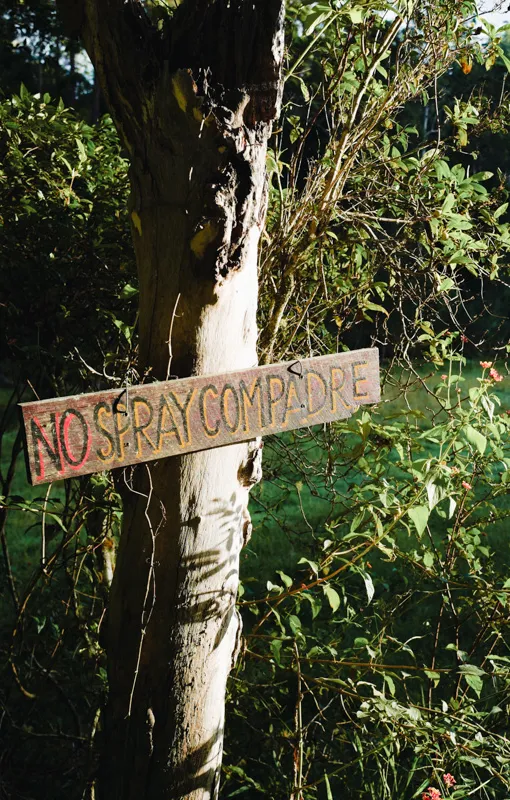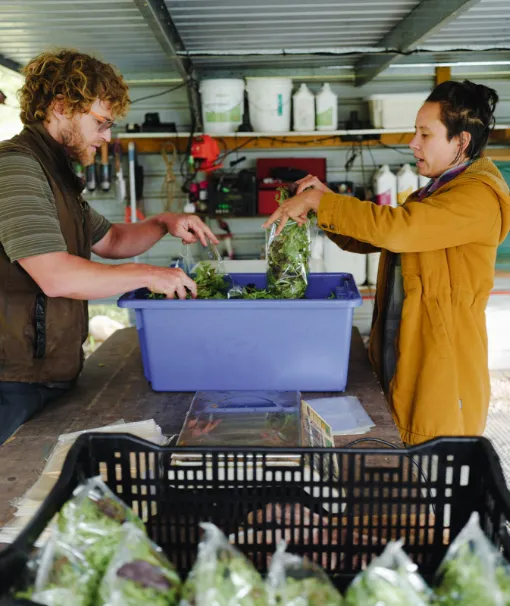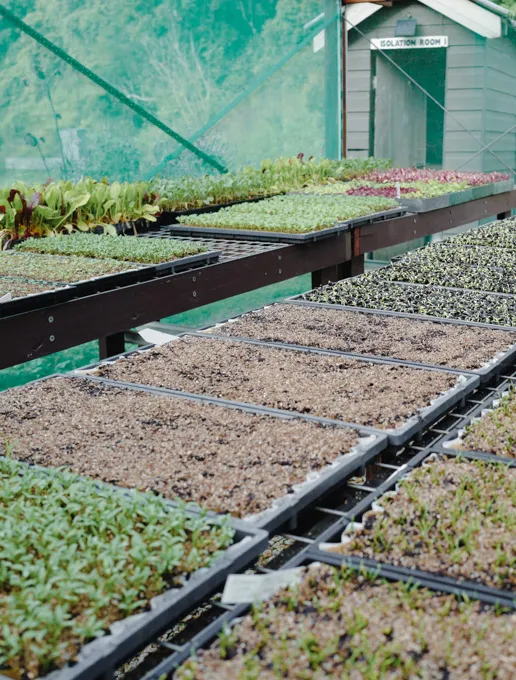Farm Yarns – Mandarin Bend And North Arm Farms
“Regeneration is a necessity, an evolution, but not an end point. It’s so much more”
Meet Kaycee & Tom, The Mandarin Bend + North Arm Farms
Kaycee and Tom both came to farming in their own ‘organic’ way. Tom says he has always been a farmer at heart, purchasing his first calf in his teens before becoming a ‘dog’s body’ on local farms while completing his environmental science-come-ecological agriculture studies.
Kaycee always fundamentally knew she would work with food. Her love of cooking leading her to an internship with a biodynamic CSA operation (Community Supported Agriculture) before becoming her own market gardener. Their original passion to seek out wealth of the ecological kind continues to inspire them today and is evident in the evolution of their operation at The Mandarin Bend.
While Kaycee and Tom may only be operating a 1 acre plot, they are proving that size doesn’t necessarily dictate productivity and that there is strength – and diversity – in unity.
The model they have created with North Arm Farms, a four-part farming collective located in the Nambucca Valley on the lands of the Gumbaynggirr people, is an encouragement for young farmers throughout the country. Their operation navigates the usual challenges of land access through collaboration and co-creation, the result of which serves not only the landscape, but also their communities and each other.
“I have a desire to change our broken food system – to educate people about the joys and benefits of seasonal, organic eating and to inspire more young people to connect back to the land and start growing food.”
Kaycee
What was the catalyst for you to expand your operation and bring to life North Arm
Farms?
K: Tom and I had built a little online veggie box system where people could jump on The Mandarin Bend shopfront on the Open Food Network and order a customised veggie box from us.
The challenge was we were only doing about 20-30 boxes a week (plus farmers markets) and had to grow a lot of variety on a really small scale to keep the box customers excited with diversity.
I dreamed of being able to streamline things a bit, and grow just 15 crops really well instead of trying to manage 30+ crops. At the same time, we were becoming good friends with some other local veggie farmers in the area yet competing with them at the farmers markets.
It was pretty clear that we should join forces for our online box system. We could expand our customer base, yet streamline our farm, and stop competing for sales. So I pitched the idea to the other farms and brought everyone on board.
We allocated certain crops to each farm, did a heap of marketing and promotion and got started. It just made sense and seemed like the next logical step for our farm.
What’s the difference between your model and a Community Supported Agriculture (CSA) model?
North Arm Farms is not a subscription mode like a CSA. We are essentially just a shopfront, where any person can order from our shop as often or as infrequently as they please. We don’t sell any set boxes, everything is fully customised, which I think is quite unique.
I think this is an important factor in a regional location like ours as many people have little gardens and grow a bit of this and a bit of that. They don’t want to get a set box each week because they might already be growing those things in their garden.
Each farm manages their own inventory on their Open Food Network profile, and our profiles are linked together under the North Arm Farms hub. Once customers jump onto our shopfront hey can order from any of our farms in one transaction.
Once the order cycle closes each week, we harvest and take all our produce to our packshed and then pack everyone’s boxes and deliver. Some customers order every single week, some every fortnight, some very sporadically. We even get people who are just visiting the area for a holiday but want some local, organic produce to cook with!
“Farming has to change and evolve in so many ways going forward. I hope that our model could be adopted by more farmers in the future, as it really feels like a win-win for everyone.”
Why do you think that this model has not been utilised to its potential in more places?
North Arm Farms’ are really lucky in a sense that our 4 farms (7 farmers) all live within half an hour of Bowraville, which is our home base. We are also lucky in that we’re all on the same wavelength in terms of being super passionate for local, organic food and we’re all good friends.
Our situation is quite unique. I think this model would be utilised more if there were more small-scale organic farmers out there! There aren’t many of us in Australia, and we are pretty spread out. I think we will see more of it in the future though.
Farming has to change and evolve in so many ways going forward. I hope that our model could be adopted by more farmers in the future, as it really feels like a win-win for everyone.
What are the barriers you face as a collective? How have you learnt to navigate these?
The first year or two was really intense. We worked really closely together to get things off the ground in that first year getting so we had to get to know each other on a much deeper level. We all communicate and express things differently which took a while to learn and adjust to.
Farming is an all encompassing career and there are no boundaries between your personal life and work life, so personal issues could spill over into the business at times. But since then it has been smooth sailing! It works really well now that we understand each other.
We haven’t faced any other real barriers besides occasionally delicately walking the friendship/business relationship line. It feels like we just go from strength to strength. Everything about this model just feels right and everything seems to really flow for us!
How do you hold yourselves accountable to your vision/mission?
We get together at the start of each year to do a bit of a check-in. We share what worked for us and what didn’t, not only as a collective but on our own farms and for ourselves individually.
We set some goals for the collective for the coming year and make sure we are all on the same page. We love food so we love getting together throughout the year for a meal and check-in too.
“Eaters are seeking out the story behind the food and it’s getting easier all the time to participate in that story.”
What do you think the future looks like for small scale regional farming?
Just to contextualise for a moment, we’re at a bit of a crossroads in Ag right now. It seems broad-acre commodity agriculture is heading further down the corporatised, aggregate, get-big route.
Many medium scale ’Mum and Dad’ operations who feed into that system are being squeezed out, bought out or broken down. And then at the other end, the energy behind the small scale movement is really building. There are crew who still leave the movement for various reasons, but when they do, it’s often new young people doing awesome things that seem to come into their place several fold.
So the multiplication is on, big time! There’s much more info at our fingertips about how our food is grown, and the collective consciousness is growing. Eaters are seeking out the story behind the food and it’s getting easier all the time to participate in that story. So given the current trajectory, the future looks good from where we’re standing
What outside support would ensure growth and prosperity for SSRF?
The main thing is, we all need to keep turning up for it. Rain, hail or shine. For example, when a farmer turns up to the local market with their goods and there’s a bit of rain about, don a brolly and come down and support them! Because produce doesn’t stop for the weather and we don’t stop eating for the weather either..
Another factor we need to consider is that farming is a calling that is now being adopted by the ‘landless’, and typically young ones at that…Certainly a lot younger than the average 60 year-old Australian farmer.
So with that comes all sorts of insecurities. Especially when everything you do on the land as an organic, regen farmer begins with building soil fertility – a process that takes time, resources and a lot of energy.
Younger people come into the industry, often idealistically, and pour everything they have into rented land so if that doesn’t work out, it can leave them very exposed, especially given the whims of farming.
Improving land security is a big one. There is some financial support out there to help people find their feet in farming but possibly not enough, and we need to ensure that government overreach doesn’t crush small-scale production.
“When farmers turn up to the local market with their goods and there’s a bit of rain about, don a brolly and come down and support them! Because produce doesn’t stop for weather and we don’t stop eating for weather either..”
What does The Mandarin Bend look like in 5 years and how do you see your relationship with the land changing?
With every new farming year, we improve upon what we do to make it easier on ourselves, because it can be a physically taxing occupation. When we started out, things were pretty rudimentary. Being 6 years into our growing career, we’re now starting to hum. It feels good.
So in five years time, we should be well and truly set-up, hopefully in a way that makes our little business even more resilient to the type of climate shocks we’re increasingly experiencing. In terms of expansion of sales etc, there’s no intentions there.
We’re at a sweet spot right now, and we’d prefer to see a mosaic of more farms doing the type of things we do, rather than us extending ourselves to produce more. There’s so much land on this farm (160ha), and being a headwater property it has incredible conservation value.
In 5 years, I hope to be able to spend a lot more time focused on whole-of-landscape rehabilitation, not just on farming and production per se, babes in toe.
Is there anything commonly misunderstood about the work that you do?
Because we’re really small scale (under 1 acre of production), we’ve been told that we’re not ‘real farmers’. Scale is a perverse thing in Australia. I think you’d find the average Australian has visions of farming occurring across large ranges and vast flat paddocks.
People ask if what we do is even viable! And they’re blown away when they find out it can support not only us, but that we employ others as well. It’s incredible what a small piece of land, managed well, can produce.
Another misconception is price. We ran a little experiment the other day based on what we sell through North Arm Farms, versus off the shelf Certified Organic and conventionally grown produce in one of the big supermarket chains.
Our produce price point sat nicely between the supermarket conventionally grown and Certified Organic produce…but the benefits of supporting a little business like North Arm Farms are so much richer.
On expansion: “We’d prefer to see a mosaic of more farms doing the type of things we do, rather than us extending ourselves to produce more.”
What does Regeneration mean to you?
Regeneration is a necessity, an evolution, but not an end point. It’s so much more nuanced than past terms like ‘sustainable’ or ‘organic’ that largely worked to maintain the status quo.
It’s all-encompassing, pro-life, pro-diversity, future-assuring and definitely not limited to agriculture. And it’s really great to hear it being adopted in economic circles for example. It aims to give back. But it’s also really easily co-opted, and that could be to its detriment. However, it’s where we need to head, maybe with our eyes on something beyond regeneration, like reciprocity.











